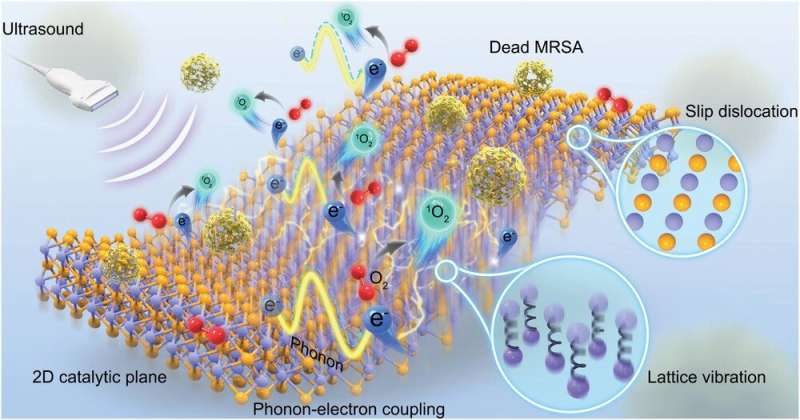[ad_1]

A analysis workforce led by Professor Kelvin Yeung Wai-kwok from the Division of Orthopaedics and Traumatology, College of Scientific Medication, LKS School of Medication, the College of Hong Kong (HKUMed) has invented a non-invasive and non-antibiotics know-how to successfully scale back methicillin-resistant Staphylococcus aureus (MRSA) an infection in bony tissue.
The novel antibacterial nano-sheets can launch a considerable quantity of reactive oxygen species (ROS) topic to ultrasound stimulation. With the engulfment of neutrophil membrane (NM), the nano-sheets are in a position to actively seize the MRSA micro organism deeply seated in bony tissue and successfully eradicate 99.72% ± 0.03%. The analysis has been revealed in Superior Supplies.
Bone an infection (osteomyelitis) is an an infection in bone or bone marrow brought on by micro organism, fungi, or different microorganisms. The widespread causative pathogenic organism is MRSA. Extreme infections can put sufferers on the threat of amputation, and even induce life-threatening sepsis. In scientific apply, the therapy of bone tissue an infection usually entails antibiotics and surgical debridement to take away the contaminated bone or tissue.
Nevertheless, extreme use of antibiotics not solely compromises the host’s innate immune operate, however might also inevitably induce the emergence of drug-resistant pathogens. Not too long ago, phototherapy (together with photodynamic and photothermal remedy) has been utilized as an antibiotic-free technique to deal with bacterial infections. Nevertheless, typical phototherapy is unable to handle deep tissue an infection in bones on account of its restricted penetration energy.
The researchers subsequently pursued an alternate antibiotic-free technique harnessing the penetration energy of ultrasound in human tissues.
The HKUMed analysis workforce invented a brand new two-dimensional (2D) sonosensitizer, Ti3C2-SD(Ti3+) nano-sheets. A standard sonosensitizer organized in zero-dimension yields restricted effectivity in ROS technology.
The progressive 2D sonosensitizer, containing an abundance of planar catalytic websites, can successfully generate a considerable quantity of ROS when it’s triggered by an ultrasound sign. After being coated with a neutrophil membrane (NM), the NM-Ti3C2-SD(Ti3+) nano-sheets (NM-nano-sheets) can actively monitor down the MRSA micro organism in bony tissue topic to ultrasound stimulation.
In an animal mannequin, the novel nano-sheets have eradicated the MRSA micro organism in bone in additional than 99.72% of circumstances, whereas the antibiotics remedy (Vanco) is ineffective. Moreover, the NM-nano-sheets also can alleviate tissue irritation and help bone restore as soon as bony tissue an infection has been managed. As well as, the NM-coated nano-sheets don’t current any acute bio-safety points.
Professor Kelvin Yeung Wai-kwok remarked, “Our design has achieved a qualitative leap wherein the ROS catalytic web site in sonosensitizer has remodeled from zero-dimensional to two-dimensional. This invention can remarkably enhance the manufacturing of bactericide (ROS). We might also think about making use of this invention to the post-operation bacterial an infection generally seen in bone most cancers sufferers or the sufferers with cystitis and peritonitis sooner or later.”
Extra data:
Congyang Mao et al, Realizing Extremely Environment friendly Sonodynamic Bactericidal Functionality by the Phonon–Electron Coupling Impact Utilizing Two‐Dimensional Catalytic Planar Defects, Superior Supplies (2022). DOI: 10.1002/adma.202208681
Supplied by
The College of Hong Kong
Quotation:
Workforce develops 2D ultrasound-responsive antibacterial nano-sheets to successfully deal with bone tissue an infection (2023, March 23)
retrieved 23 March 2023
from https://phys.org/information/2023-03-team-Second-ultrasound-responsive-antibacterial-nano-sheets.html
This doc is topic to copyright. Aside from any honest dealing for the aim of personal research or analysis, no
half could also be reproduced with out the written permission. The content material is supplied for data functions solely.
[ad_2]